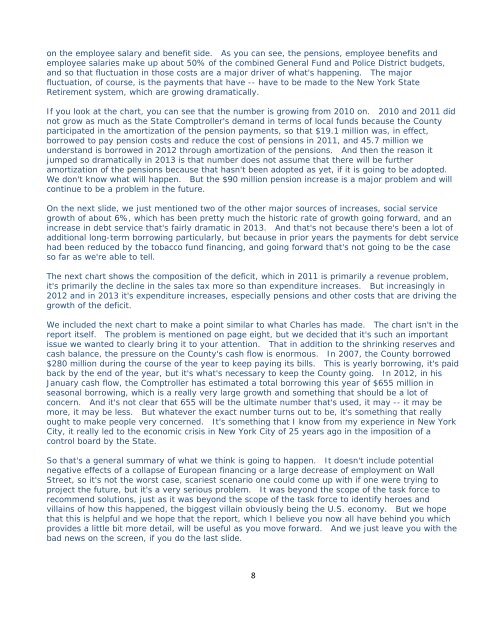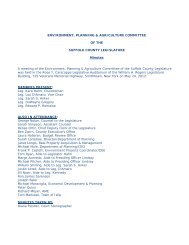BUDGET & FINANCE COMMITTEE OF THE SUFFOLK COUNTY ...
BUDGET & FINANCE COMMITTEE OF THE SUFFOLK COUNTY ...
BUDGET & FINANCE COMMITTEE OF THE SUFFOLK COUNTY ...
You also want an ePaper? Increase the reach of your titles
YUMPU automatically turns print PDFs into web optimized ePapers that Google loves.
on the employee salary and benefit side. As you can see, the pensions, employee benefits and<br />
employee salaries make up about 50% of the combined General Fund and Police District budgets,<br />
and so that fluctuation in those costs are a major driver of what's happening. The major<br />
fluctuation, of course, is the payments that have -- have to be made to the New York State<br />
Retirement system, which are growing dramatically.<br />
If you look at the chart, you can see that the number is growing from 2010 on. 2010 and 2011 did<br />
not grow as much as the State Comptroller's demand in terms of local funds because the County<br />
participated in the amortization of the pension payments, so that $19.1 million was, in effect,<br />
borrowed to pay pension costs and reduce the cost of pensions in 2011, and 45.7 million we<br />
understand is borrowed in 2012 through amortization of the pensions. And then the reason it<br />
jumped so dramatically in 2013 is that number does not assume that there will be further<br />
amortization of the pensions because that hasn't been adopted as yet, if it is going to be adopted.<br />
We don't know what will happen. But the $90 million pension increase is a major problem and will<br />
continue to be a problem in the future.<br />
On the next slide, we just mentioned two of the other major sources of increases, social service<br />
growth of about 6%, which has been pretty much the historic rate of growth going forward, and an<br />
increase in debt service that's fairly dramatic in 2013. And that's not because there's been a lot of<br />
additional long-term borrowing particularly, but because in prior years the payments for debt service<br />
had been reduced by the tobacco fund financing, and going forward that's not going to be the case<br />
so far as we're able to tell.<br />
The next chart shows the composition of the deficit, which in 2011 is primarily a revenue problem,<br />
it's primarily the decline in the sales tax more so than expenditure increases. But increasingly in<br />
2012 and in 2013 it's expenditure increases, especially pensions and other costs that are driving the<br />
growth of the deficit.<br />
We included the next chart to make a point similar to what Charles has made. The chart isn't in the<br />
report itself. The problem is mentioned on page eight, but we decided that it's such an important<br />
issue we wanted to clearly bring it to your attention. That in addition to the shrinking reserves and<br />
cash balance, the pressure on the County's cash flow is enormous. In 2007, the County borrowed<br />
$280 million during the course of the year to keep paying its bills. This is yearly borrowing, it's paid<br />
back by the end of the year, but it's what's necessary to keep the County going. In 2012, in his<br />
January cash flow, the Comptroller has estimated a total borrowing this year of $655 million in<br />
seasonal borrowing, which is a really very large growth and something that should be a lot of<br />
concern. And it's not clear that 655 will be the ultimate number that's used, it may -- it may be<br />
more, it may be less. But whatever the exact number turns out to be, it's something that really<br />
ought to make people very concerned. It's something that I know from my experience in New York<br />
City, it really led to the economic crisis in New York City of 25 years ago in the imposition of a<br />
control board by the State.<br />
So that's a general summary of what we think is going to happen. It doesn't include potential<br />
negative effects of a collapse of European financing or a large decrease of employment on Wall<br />
Street, so it's not the worst case, scariest scenario one could come up with if one were trying to<br />
project the future, but it's a very serious problem. It was beyond the scope of the task force to<br />
recommend solutions, just as it was beyond the scope of the task force to identify heroes and<br />
villains of how this happened, the biggest villain obviously being the U.S. economy. But we hope<br />
that this is helpful and we hope that the report, which I believe you now all have behind you which<br />
provides a little bit more detail, will be useful as you move forward. And we just leave you with the<br />
bad news on the screen, if you do the last slide.<br />
8






